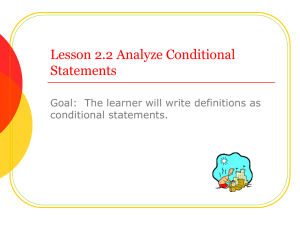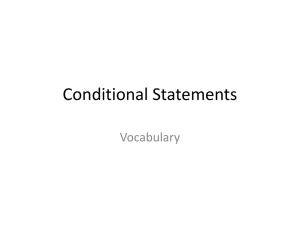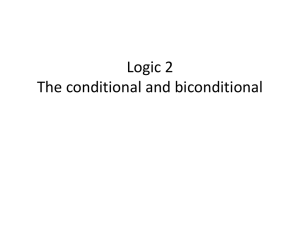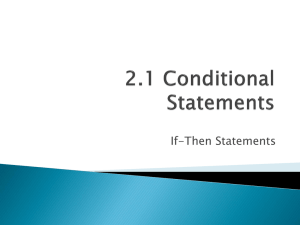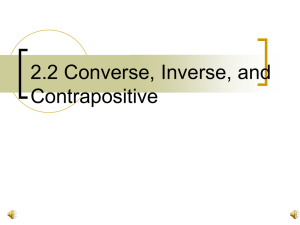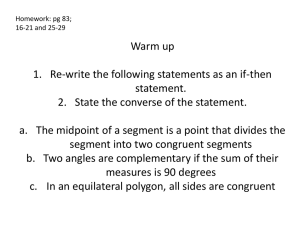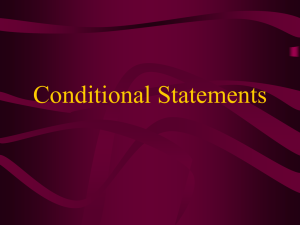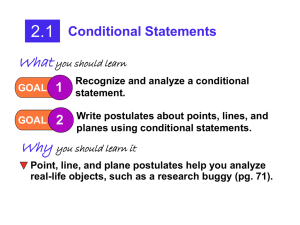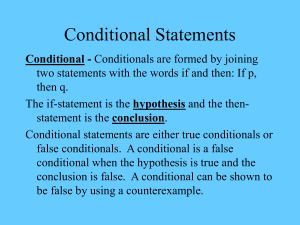9-29: 2.2 handout
advertisement
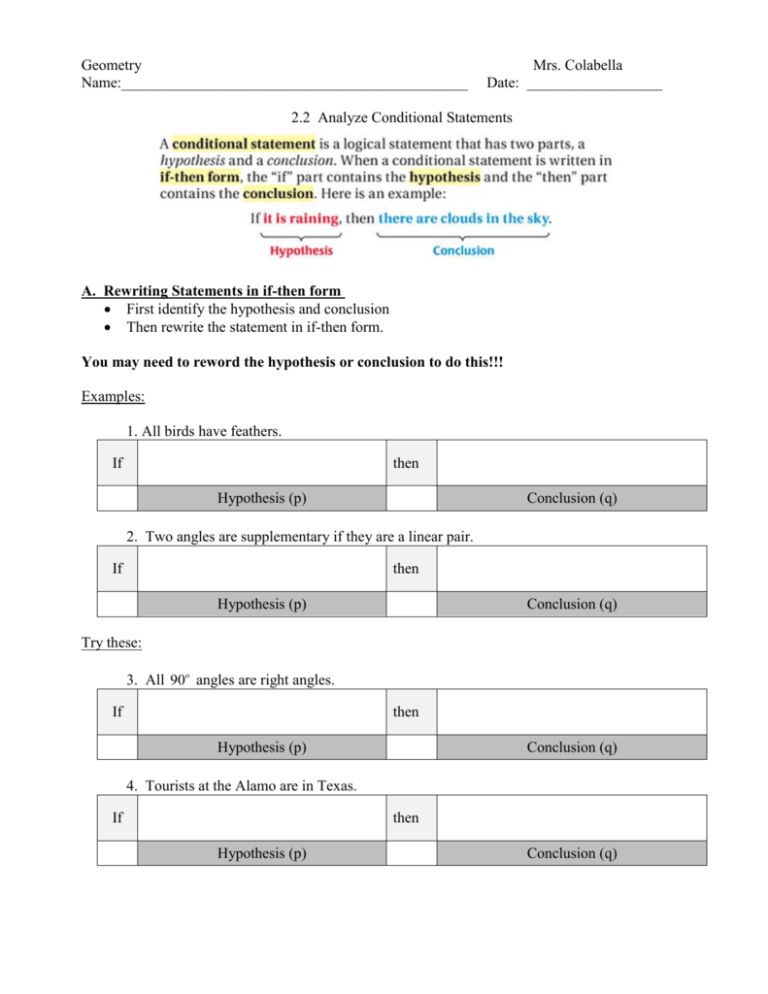
Geometry Name:______________________________________________ Mrs. Colabella Date: __________________ 2.2 Analyze Conditional Statements A. Rewriting Statements in if-then form First identify the hypothesis and conclusion Then rewrite the statement in if-then form. You may need to reword the hypothesis or conclusion to do this!!! Examples: 1. All birds have feathers. If then Hypothesis (p) Conclusion (q) 2. Two angles are supplementary if they are a linear pair. If then Hypothesis (p) Conclusion (q) Try these: 3. All 90o angles are right angles. If then Hypothesis (p) Conclusion (q) 4. Tourists at the Alamo are in Texas. If then Hypothesis (p) Conclusion (q) B. Symbolic Notation In the examples of conditional statements, the hypothesis is marked as “p” and the conclusion as “q.” Using this, a conditional statement can be written p q , or “p implies q.” C. True or False? Conditional statements can be either true or false. To show that a conditional statement is true, you must prove that the conclusion is true every time the hypothesis is true. To show that a conditional statement is false, you need to give only one counterexample. A counterexample is a situation where the hypothesis is true, but the conclusion is false. Examples: 1. If it is raining, then I have an umbrella. This statement is true if you have your umbrella every time it rains. If there is only one counterexample where it was raining, but you did not have your umbrella, then the statement is false. 2. If mA is 85o , then the measure of the complement of A is 5o . Since the complement of A is always 90o minus mA , it will always be 5o . D. Negation A negation of a statement is the opposite of the original statement. Examples 1.Statement – The ball is red Negation – The ball is not red. 2. Statement – The cat is black Negation – The cat is black Notice that when the original statement is negative, the negation is positive. In symbolic notation, the negation of p is written : p and the negation of q is : q. E. Related Conditionals There are three related conditionals: the converse, the inverse, and the contrapositive. Converse – To write the converse of a conditional statement, exchange the hypothesis and the conclusion. In symbolic notation, the converse is written q p , “q implies p” Inverse – To write the inverse, negate both the hypothesis and the conclusion. In symbolic notation, the converse is written : p : q Contrapositive - First write the converse, then negate both the hypothesis and conclusion. In symbolic notation, the contrapositive is written : q : p Example Original statement: Great Danes are large dogs. Write as a conditional statement If then Hypothesis (p) Conclusion (q) Write the converse by reversing the hypothesis and the conclusion. If then q p Write the inverse by negating the hypothesis and the conclusion. (Note – go back to the original order with the hypothesis (p) first.) If then : p : q Write the contrapositive by negating both parts of the converse. If then : q : p Try this 1) Original Statement: If you are in Warren County, then you are in New Jersey. This is already in if-then form. Write the converse, inverse and contrapositive. Write the converse by reversing the hypothesis and the conclusion. If then q p Write the inverse by negating the hypothesis and the conclusion. (Note – go back to the original order with the hypothesis (p) first.) If then : p : q Write the contrapositive by negating both parts of the converse. If then : q 2) Original Statement: The measure of a straight angle is 180o . As a conditional statement: Inverse: Converse: Contrapositive: : p Biconditional Statements Even if the original conditional statement is true, the related converse and inverse might not be true. The most obvious example is a statement like “Try this #1” If you are in Warren County, then you are in New Jersey. This is true. If you are in New Jersey, then you are in Warren County. This is not true, because you can be in New Jersey and be in Morris County, for instance. In “Try this #2” both the original statement and the converse are true: Original statement: If an angle is a straight angle, then it measures 1800 . Converse: If an angle measures 180o , then it is a straight angle. When a conditional statement and its converse are both true, you can write them as a single biconditional statement using the phrase “if and only if.” An angle is a straight angle if and only if it measures 180o . Every biconditional statement includes the language “if and only if.” All definitions in math are biconditional statements. In symbolic notation, biconditional statements are written p q . Example If two lines intersect to form a right angle, then they are perpendicular lines. If two lines are perpendicular, then they intersect to form a right angle. These two statements can be combined into the single biconditional: Two lines are perpendicular if and only if they intersect to form a right angle. o Note that since a biconditional works both ways, it can be written with either phrase first. This could also correctly be written as: Two lines intersect to form a right angle if and only if they are perpendicular. Try this Write the statement in if-then form. Then write its converse. If the converse is true, combine the statements to form a biconditional. An angle with a measure between 90o and 180o is called obtuse. If-then form: Converse: Biconditional (if the converse is true):
